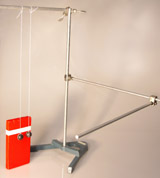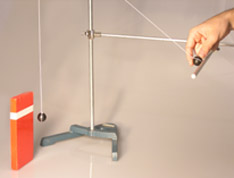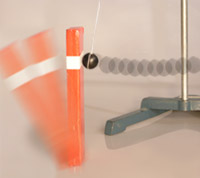For this demonstration we use inelastic and elastic balls that collide with a plywood board standing on end. These balls are equal in mass and size (1″ diameter) and are suspended from the arm of a lab stand. The instructor should release the balls one after the other from the same height. When the inelastic ball hits the board, it will show no effect. However, the board will fall over when hit with the elastic ball, as the momentum transferred by the elastic ball is twice that of the inelastic one.
Materials:
- Elastic and inelastic black balls of equal mass and size attached to string
- Plywood board
- Hanging apparatus (Figure 1):
- Stand
- Three rods
- Three right-angle brackets
Demo:
Place the plywood board about fifteen centimeters away from the hanging pendulums and adjust the square arm to the position the pendulums will be released at. You may vary these lengths as desired. Pull the inelastic ball back to the square arm and release, observing that the plywood board stays stationary after the collision between the ball and board. Now do the same with the elastic ball, noticing that it knocks the board down (Figures 2 and 3). Also note that the elastic ball bounces farther back after the collision than the inelastic ball does.
Explanation:
Some definitions:
- U = gravitational potential energy = mgh
- K = kinetic energy = 1/2 mv2
- D = energy lost to deforming the inelastic ball, heat, and friction
- p = momentum = mv
- v1 = speed of ball just before collision
- v2 = speed of ball just after collision
- u = speed of the board just after collision
The collisions between the inelastic and elastic balls and the board are partially inelastic collisions. This means that some kinetic energy is lost during these collisions, or rather, that kinetic energy is not conserved.
While both of these collisions are partially inelastic, the inelastic ball loses more kinetic energy while colliding with the board than the elastic ball does. This is well explained by dunecraft.com:
“Though they look the same, each ball is made of a different material. The ball that bounces is made of a natural rubber. The natural rubber polymer’s molecules are crossed linked by another substance. This prevents the molecules of rubber to slide past each other when a force is applied to the ball. When it makes contact with the ground, the ball flattens momentarily before bouncing back to its original shape. The upward energy created when it returns to its normal shape causes the entire ball to bounce upward again. The process repeats itself until the ball has no more energy and comes to a stop.
The [inelastic] ball is made of butyl rubber. It acts just like the bouncing ball, except it absorbs more of the energy. The energy that makes the bounce ball bounce again is absorbed by butyl rubber, so it ‘dies’ almost immediately. This is because there are no cross-links between the butyl rubber. When force is applied, the molecules in the ball slide past one another. The energy goes into deforming the ball.”
[Source]
We can see this directly by noticing that the inelastic ball does not knock over the board and also does not bounce back to its original height, indicating that a significant amount of kinetic energy is lost to deforming the ball.
The potential energy immediately before and after the collision for both balls are the same. For this reason, the potential energies cancel out. Let’s look at the kinetic energy and momentum for the two balls.
For the inelastic ball, the total kinetic energy immediately after the collision is equivalent to the kinetic energy of the ball after the collision minus the energy lost due to friction:
Ktotal = Kball – D
In addition, because some kinetic energy is lost, there is less kinetic energy in the system to transform into potential energy, and the ball cannot reach its original height.
During collision the ball does not transfer enough momentum into the board to knock it over. Most of the momentum is transferred back into the ball, deforming it.
mv1 = mv2 + pboard + pdeform
pdeform ≅ mv1
(mv2, pboard very small)
The momentum leftover after transferring to the board and deforming the ball is not enough to push the ball back to its original height, so the ball will barely bounce off of the board, if at all.
The elastic ball does not deform as much and loses less kinetic energy, transferring more kinetic energy and momentum to the board than the inelastic ball does. It knocks over the board and still bounces back close to its original height, indicating that a small amount of kinetic energy is lost to deformation.
For the elastic ball, the total kinetic energy immediately after the collision is equivalent to the kinetic energies of the ball and board after the collision minus the energy lost due to deformation:
Ktotal = Kball + Kboard – D
In this case, the total kinetic energy after the collision is shared between the ball and the board, as some of the initial kinetic energy was transferred to the board during the collision.
Most of the its momentum is transferred back into the ball and board. The ball transfers enough momentum into the board to knock it over, and still has enough momentum after the collision to bounce nearly to its original height. This indicates that only a small amount of momentum in transferred into deformation in the elastic case.
mv1 = mv2 + mu + pdeform
mv1 ≅ mv2 + mu
(pdeform very small)
Notes:
- One can test which ball is elastic and which is inelastic by dropping each. The elastic ball will bounce, while the inelastic one will not.
- Freezing the balls will reverse the effects described above and can be included in this demo.
- Use of a video camera recommended for large audiences.
Written by Lydia Seymour


